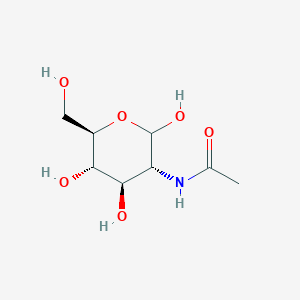| General Information of MET (ID: META00208) |
| Name |
N-Acetyl-D-glucosamine
|
| Synonyms |
Click to Show/Hide Synonyms of This Metabolite
2 Acetamido 2 deoxy D glucose; 2 Acetamido 2 deoxyglucose; 2-(Acetylamino)-2-deoxyhexose; 2-Acetamido-2-deoxy-D-glucopyranose; 2-Acetamido-2-deoxy-D-glucose; 2-Acetamido-2-deoxyglucose; 2-Acetamido-D-glucose; 2-Acetylamino-2-deoxy-D-glucose; Acetylglucosamine; GlcNAc; N Acetyl D glucosamine; N-Acetylchitosamine; N-Acetylglucosamine; N-[(3R,4R,5S,6R)-2,4,5-Trihydroxy-6-(hydroxymethyl)oxan-3-yl]acetamide
|
| Source |
Endogenous;Escherichia Coli Metabolite;Yeast Metabolite;Food;Microbial
|
| Structure Type |
Carbohydrates and carbohydrate conjugates (Click to Show/Hide the Complete Structure Type Hierarchy)
Organic oxygen compounds
Organooxygen compounds
Carbohydrates and carbohydrate conjugates
|
| PubChem CID |
|
| HMDB ID |
|
| Formula |
C8H15NO6
|
| Structure |
<iframe style="width: 300px; height: 300px;" frameborder="0" src="https://embed.molview.org/v1/?mode=balls&cid=439174"></iframe>
|
 |
|
3D MOL
|
2D MOL
|
|
Click to Show/Hide the Molecular/Functional Data (External Links/Property/Function) of This Metabolite
|
| KEGG ID |
|
| ChEBI ID |
|
| FooDB ID |
|
| ChemSpider ID |
|
| METLIN ID |
|
| Physicochemical Properties |
Molecular Weight |
221.21 |
Topological Polar Surface Area |
119 |
| XlogP |
-1.7 |
Complexity |
235 |
| Heavy Atom Count |
15 |
Rotatable Bond Count |
2 |
| Hydrogen Bond Donor Count |
5 |
Hydrogen Bond Acceptor Count |
6 |
| Function |
N-Acetyl-D-Glucosamine (N-acetlyglucosamine) is a monosaccharide derivative of glucose. Chemically it is an amide between glucosamine and acetic acid. A single N-acetlyglucosamine moiety linked to serine or threonine residues on nuclear and cytoplasmic proteins -O-GlcNAc, is an ubiquitous post-translational protein modification. O-GlcNAc modified proteins are involved in sensing the nutrient status of the surrounding cellular environment and adjusting the activity of cellular proteins accordingly. O-GlcNAc regulates cellular responses to hormones such as insulin, initiates a protective response to stress, modulates a cell's capacity to grow and divide, and regulates gene transcription. In humans, it exists in skin, cartilage and blood vessel as a component of hyaluronic acid, and bone tissue, cornea and aorta as a component of keratan sulfate.
|
|
Regulatory Network
|
|
|
|
|
|
|
|
|
 click to show the details of this protein
click to show the details of this protein
 click to show the details of experiment for validating this pair
click to show the details of experiment for validating this pair

